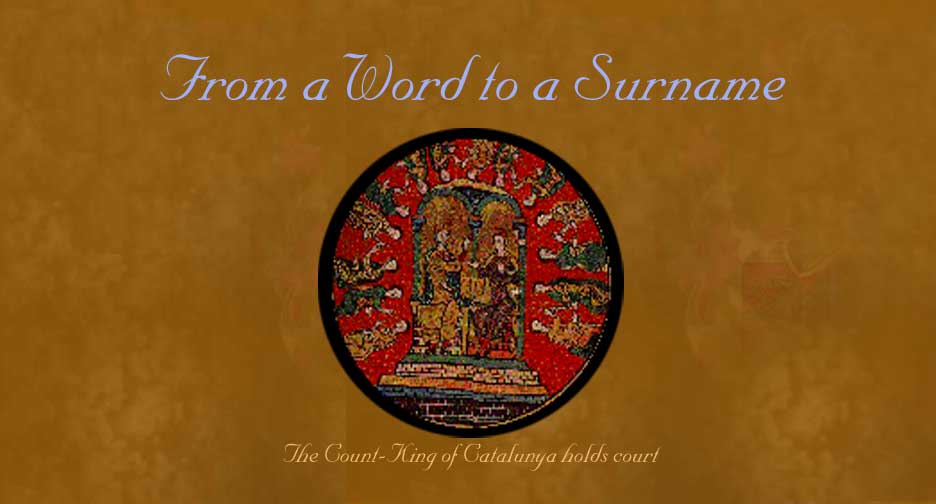 |
||
 |
||
|
1. The Dawn of Surnames Sometime in the 10th century, people started to add a suname to their given birth names, as a marker to establish family or geographical procedence, their work trade, an animal, a plant, a geological feature, a physical detail or as a simple way to establish an individual identity within the community. Sometimes people also acquired their landlord's given names a surnames, as they would often be born and raised within their master's domains.These malnomes, nicknames, were eventually passed on to their next generation and even to their next of kin. Hence a Peter son of Stuart, Robert of Surrey or Jack the Smith would eventually become Peter Stuart, Robert Surrey and Jack Smith: a surname had been born. |
||
|
|
||
 |
||
|
2. Catalunya The first documented records of the surname Clavell appear in Catalunya between 1291 and 1327, in the Alphabetical Index by Father Ribera -Archivo de la Corona de Aragón-, where it mentions the following persons:
We calculate that, regardless of the mortality rates of given historical period, there are at least three generations of any given family within a hundred years. It would be fair to assume then that these earliest Clavells mentioned above were descendants of Clavell family(ies), and could probably stretch back their ancestry for quite a few generations going to the 1000's and perhaps beyond. This portion of our investigation is still under research, as we're still trying to find out how far back the surname Clavell goes in Catalunya. In this period of Catalunyan history (880-1200), clavell meant nail, spice clove (because of its similar shape to the nail), and a carnation that smelled just like spice clove. From which of this definitions, or by extension trades (a metal smith, a spice merchant, or a flower grower), did the Clavell surname evolved is not known. But it seems likely that the surname first apppeared in connection with the oldest definition, the most vital and common of these objects: the nail. Catalunya traded heavily with all the Meditarrenean states, and had lands stretching all the way to Italy. They even ruled over Naples, Sardinia and Sicily, and were in the process of permanently allying the English and the Catalunyan crown through a Royal marriage between Alfonso II and princess Leonore of England. I mention this here so that the reader is aware that Catalunyans were traveling and emigrating to key points of its kingdom and establishing diplomatic ties with all the main countries in Europe, probably trading goods as well as citizens.To see map click here. Alas, the royal marriage did not take place, as Alfonso II, Count of Barcelona, died before the wedding, in 1291. But the relations remained good, and both countries continued to be allies until the Kingdom of Catalunya came to an end on 1450, and was absorbed into the Castillian Spanish Kingdom. Whether Berenguer Clavell or Miguel Clavell moved permanently to England after their diplomatic visits and had families there is uncertained but possible. Yet, I feel that the Clavells of Dorset and Devon, England, bear no relation whatsoever to the Catalunyan branch. On the other hand, there were a Richard Clavell (1386) and his daughter Joanne (1412), living in Northampton in the 1400's, that do not seem to be related to the Clavells of Southern England. Perhaps they were descended from these previous Catalunyan visitors? The surname also entered Castillian Spain as Clavel, but with only one meaning: carnation. The surname Clavell as well as vast numbers of other Catalunyan surnames arrived in the Americas during the early 1800's. Our particular line reached Puerto Rico in 1835. Click here. Our branch originates in Mataró, a city located in the region of La Maresma, and has been the home to our direct ancestors for the last 300 years. (To see all Catalonian provinces, click here) When Esteve Clavell, a rope maker, born in Granollers in 1695, settles in Mataró with his wife Eulalia Fábregas, three new branches of the surnaame will emerge: CLAVELL-XIRALT, CLAVELL-SEVé, y CLAVELL-BERENGUER. Our ancestor Jaume Clavell Cabot comes from the Clavell-Berenguer branch. Esteve Clavell's father is Josep, a carpenter, born in the town of Sant Pere de Vilamajor, Which is very close to Granollers. These towns are inthe province of Vallés Oriental. The Vallés Oriental is home to our ancestor for roughly 700 years (1000-1700), Vilamajor being the most important place in our history. Around 1213 Vilamajor has a foundry operated by the Can (House of/ Clan) Clavell. This foundry was inside the perimeter of the feudal castle. The Can Clavell was already established by 1157, the evidence being a Loreta Clavell, member of the Can, who was the wet nurse of Alfonso I the Chaste, first-born son of Ramón Berenguer IV, the Count-King of Catalunya. To see map, click here As we mentioned in our etimology section, Clavell comes from clavellus,the latin word for construction nail, therefore it is likely that Vilamajor is the actuaal birthplace of the surname in Catalunya. The foundry Can Clavell is the strongets clue we have as to the development of Clavell. Although this original foundry is gone, the Can builds a new structure, a homebase, in 1574, in Sant Pere de Vilamajor, which still stands. To see photo, click here. |
||
|
|
||
 |
||
|
3. France The surnames Clavel (in Provençe) and Claville (in Normandy) appeared around the same time Clavell appeared in Catalunya. Towns that still preserved the Catalunyan heritage sprung up, such as Barcelonette (in honor of Barcelona), and towns bearing Claville (a variant of Clavel) were, and are, numerous too. The Clavels and Clavilles of Provençe and Normandy entered England during the Norman Conquest in 1066. The words claville and clavel also entered the English language, and they were used to designate the keystone of an arch. Eventually, the surname Clavel also moved to French speaking Switzerland. French settlers brought the surname to French-speaking Canada and probably to other French territories, from 1700 to the present day. According to Thomas Clavel, who emailed me regarding the Clavel surname in France, there's another theory about it's origins in France, which I have copied below: "Hello,
|
||
|
|
||
 |
||
|
4. England In 1066 the Normans invaded England and ended the rule of the Bretons. With them came laws and language, and plenty of Normans as well. These re-settled in England soon after the conquest. The Dorset historical texts consider Clavell "one of its most ancient names, older probably than the first written records of individuals with that surname". Yet it's intriguing to see that the name doesn't gel as "Clavell" until the 1400's, as it is previously spelled in various ways, with "Clavile" being the main variant. The first written mention of a Claville in England appears in the Domesday Book, written in 1086. This book was the brainchild of the court as a way to tax all property owners. A Walter de Claville, a Norman, saved the life of the Conqueror during a Royal hunt and was given titles and lands in England. This Claville also appears as Clavile in other pages of the book, as his descendant Walter de Clavile spells it in 1166. His children spelled it differently as well: Robert de Clavilla, Robert de Clavile, Radulphus de Clavill, and finally the first written mention of Clavell proper, their brother Walter de Clavell. They were owners of much of Dorset and Devon, and remained so until the 19th century. It is finally here, in 1425, that the surname becomes permanently Clavell, as it had been continuosly spelled Clavile and its variants until then. According to the historical text on the pedigree of this family, it dies out in the 19th century, but admits that a more recent Captain Clavell of the Royal Navy, 19th century, might be descended from this Clavells of Purbeck and Smedmore. (To see original excerpt It's also possible that the persons who wrote this historical text (1860) may have mixed more than a family, and instead of all being variations of Claville they could well be dfferent individuals, as would be the case if perhaps some of the mentioned persons were named originally Clavel or Clavell. No mention is made of a Richard Clavell and his daughter Joanne, living in Northampton in the 1400's , or of the Clavell ancestor that traveled from England to Spain in the early 17th century, as the writer James Clavell once informed my uncle Dr. Juan Eugenio Clavell Montes in a letter written in 1962. According to this letter, this Clavell was involved in privateering (better known as court-sanctioned buccaneering-piracy) and had been sent to Spain to set up a clandestine operational base for the English. To read letter, Because of the clear line that evolves amongst the Clavells of Dorset and Devon, it is unrealistic to think that this particular line came from a Catalunyan ancestor. Besides, as I have established before, the surname Clavell has been written and spelled the same way since the 12th century, if not earlier, in Catalunya, without any variants. On the other hand, any other Clavell in England unrelated to the Dorset branch could very well be a descendant of Catalunyan diplomats visitng England from about 1150 to 1450. Settlers from England brought the name to English-speaking America, Australia and New Zealand, and probably to other parts of the British Empire.
|
||
|
|
||
|
|
||
|
|
||
|
|
||
|
|